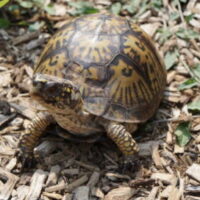 Purdue University - Extension - Forestry and Natural Resources
Purdue University - Extension - Forestry and Natural Resources
Got Nature? Blog
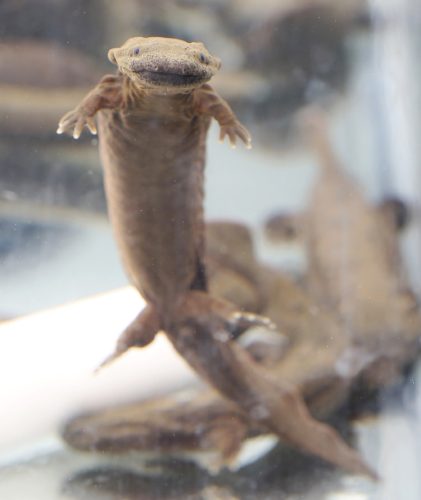 The next big step in the initiative to save the hellbenders of Indiana was completed on May 18, 2015, as three hellbenders were transferred from Purdue University’s Aquaculture Research Lab to the Columbian Park Zoo in Lafayette. This is the last of 50 hellbenders transferred from the lab to Columbian Park Zoo, Fort Wayne Children’s Zoo and Mesker Park Zoo in Evansville.
The next big step in the initiative to save the hellbenders of Indiana was completed on May 18, 2015, as three hellbenders were transferred from Purdue University’s Aquaculture Research Lab to the Columbian Park Zoo in Lafayette. This is the last of 50 hellbenders transferred from the lab to Columbian Park Zoo, Fort Wayne Children’s Zoo and Mesker Park Zoo in Evansville.
In 2013, Associate Professor of Wildlife Science Rod Williams and his team collected 300 eggs from the Blue River in Southern Indiana. These eggs grew into young hellbenders in the lab and were transferred to the three zoos to continue growing to adulthood. In the wild, hellbender mortality rate is extremely high, as high as 99%. The salamanders are at their most vulnerable state during their juvenile years, and being raised in captivity will greatly improve their chances of survival when they are released back into the wild in a couple years.
Once released, the hellbenders will be tracked via radio transmitters to monitor their movements, habitat preferences and survivorship. The last group of 18 hellbenders released into the wild had a 22.5% survival rate after one year, and Williams hopes to improve on that. A group of 80 more hellbenders will be released in 2016 with 130 in the following year. Williams’ goal of 40-50% survival rate would mark huge progress in saving the hellbenders of Indiana.
Resources
Help the Hellbender, Purdue Extension
The Nature of Teaching: Adaptations for Aquatic Amphibians, The Education Store, Purdue Extension resource center
How Our Zoos Help Hellbenders, The Education Store
Hellbenders Rock!, The Education Store
Help the Hellbender, North America’s Giant Salamander, The Education Store
How Anglers and Paddlers Can Help the Hellbender, Purdue Extension-FNR YouTube Video
Subscribe to Purdue Extension-FNR YouTube Channel
Rod Williams, Associate Professor of Wildlife Science
Purdue University Department of Forestry and Natural Resources
 A 20+ extension team led by Kara Salazar, sustainable communities extension specialist, and Michael Wilcox, assistant program leader for extension community development, have produced a new publication and curriculum titled “Enhancing the Value of Public Spaces.” This must-have spiral bound notebook and curriculum zip file download is a great resource for decision makers and local leaders developing community public spaces including park boards, planning commission members, members of organizations, public officials and staff whose missions are related to providing services, programs or management of public spaces. This program serves as a “how-to” guide for creating high-quality action plans to achieve great public spaces.
A 20+ extension team led by Kara Salazar, sustainable communities extension specialist, and Michael Wilcox, assistant program leader for extension community development, have produced a new publication and curriculum titled “Enhancing the Value of Public Spaces.” This must-have spiral bound notebook and curriculum zip file download is a great resource for decision makers and local leaders developing community public spaces including park boards, planning commission members, members of organizations, public officials and staff whose missions are related to providing services, programs or management of public spaces. This program serves as a “how-to” guide for creating high-quality action plans to achieve great public spaces.
A one day workshop starts the process with collaborative activities to identify best practices for improving public spaces with emphasis on forming partnerships to achieve desired community goals. Follow-on working group meetings provide the resources and technical support needed to plan and implement projects tailored to individual communities. The completed high quality public spaces action plan can be used as part of comprehensive planning efforts, parks and recreation master plans and fundraising initiatives.
This publication and curriculum is available as a $25 digital download or a $50 digital download with print-on-demand options.
Resources
Enhancing the Value of Public Spaces, The Education Store
Sustainable Communities, Purdue Extension
Kara Salazar, Sustainable Communities Extension Specialist
Department of Forestry and Natural Resources
Illinois-Indiana Sea Grant
Michael Wilcox
Assistant Program Leader, Extension Community Development Program
Senior Associate, Purdue Center for Regional Development
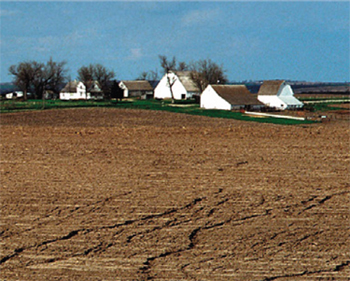 Agricultural educators, community organizers and others promoting environmental awareness can learn about the myths and realities of agricultural conservation from the perspective of a researcher, practitioner and student in a new Purdue Extension publication.
Agricultural educators, community organizers and others promoting environmental awareness can learn about the myths and realities of agricultural conservation from the perspective of a researcher, practitioner and student in a new Purdue Extension publication.
Adoption of Agricultural Conservation Practices: Insights from Research and Practice, developed by the Department of Forestry and Natural Resources at Purdue University, is available for free download from The Education Store.
The authors (Linda Prokopy, associate professor of Natural Resource Social Science; Dan Towery, Indiana Conservation Cropping System Initiative educator; and Nicholas Babin, postdoctoral research assistant in Forestry and Natural Resources) use academic studies and their own observations to address ways of motivating farmers to adopt environmentally-friendly farming practices.
To read the full article, visit Ag conservation publications available from Purdue Extension, Purdue Agriculture News.
Resources
Indiana Soils: Evaluation and Conservation Manual Review, The Education Store
Conservation Tillage and Water Quality, The Education Store
Optimizing Conservation Tillage Systems: Plant-to-Plant Uniformity is Essential for Optimum Yield in No-Till Cont. Corn, The Education Store
Linda Prokopy, Associate Professor of Natural Resource Social Science
Department of Forestry and Natural Resources
The Indiana Department of Natural Resources (INDR) has proposed an idea to the state of Indiana to begin work on a two-mile-long berm in northeast Indiana. The berm will restrict Asian carp from reaching the Great Lakes. It will prevent voracious invasive species from jumping from the Mississippi River watershed during floods to a Great Lakes tributary in Eagle Marsh southeast of Fort Wayne. INDR hopes that work will begin this fall and be completed by September 15, 2015.
View the full article, Work Near on Indiana Berm to Block Asian Carp, from greenbaypressgazette.com.
Resources
Indiana Department of Natural Resources
Asian Carp Movements Project, INDR
Eagle Marsh, Little River Wetlands Project
Invasive Asian Carp May Be Able To Spread Further Than Once Thought, Purdue News
Shocking Asian Carp Out of Midwest Rivers Not a Viable Option, Purdue News
Purdue Agriculture Research: Asian Carp, YouTube video
iTunes-Got Nature?
Got Nature? Podcasts
One of the most common questions people ask me is what to do with baby, orphaned wildlife that they find. Recently a homeowner from Carmel asked for advice regarding two hatchling box turtles that her family found in their yard. In early June, they saw the mother laying eggs. They watched the nest periodically throughout the summer only to find two hatchlings just before Labor Day. They wanted to help the young turtles survive but didn’t know what exactly they should do.
Much to the surprise of most people, my answer to this question is almost always “nothing,” regardless of the species. I can’t fault people for wanting to help. That shows me they care about wildlife and are concerned for their well-being. After all, that is a big reason why I got into my line of work. And when it comes to baby animals, we tend to really get concerned. Perhaps that is just the nurturing instinct of parents. We can sometimes forget that wildlife behave very differently than us.
Box turtles may mate anytime during the activity season. During field studies of box turtles in southern Indiana, I encountered pairs mating most often in late summer. After mating, females will store the sperm and delay fertilization up to four years. The following summer (usually late-May to early June), she will locate a nest site, dig the nest, deposit the clutch of eggs and subsequently conceal the nest. The selection of nest sites is unknown, but they generally return to the same area year after year. Some hypothesize they are returning to their own natal region since this is the case for other species of turtles. Once the female deposits her clutch of eggs, they are on their own – box turtles offer no parental care of eggs or hatchlings.
Our good-intended homeowner questioned if the hatchlings she found should be moved to a large state forest (some distance away), a local nature center or the park across the street where she thought the mother came from. Because hatchlings and juvenile box turtles are hard to find, there is very little information known about their movements. It really is not known if the hatching turtles would attempt to cross the street because that is the presumed home of their mother. However, since the wooded park clearly offers better habitat than the housing development, saving the young from a potentially perilous journey across the road is probably ok.
Moving them a long distance away is probably not a good idea and simply not necessary. Based on research of adult movements, we know adult box turtles are very familiar with their home range and are capable of finding this area if displaced from it by up to 3.3 km. Turtles moved a long distance away from their home range may establish a new home range but may also wander great distances looking for home. Similarly, taking the hatchling turtles to a nature center or wildlife rehabilitator isn’t really necessary. They are perfectly fine on their own as long as they have good habitat. Also maintaining a population of box turtles in the park depends on the influx of new turtles.
Resources
Turtles of Indiana, The Education Store
Turtles In Your Yard, Everything Wildlife
Eastern Box Turtle, Indiana Department of Natural Resources
Orphaned and Injured Animals, Indiana Department of Natural Resources
Brian MacGowan, Extension Wildlife Specialist
Department of Forestry and Natural Resources
As foresters, woodland owners and tree and wildlife enthusiasts, we hear the word safety and immediately think about making sure our hard hat is packed, our gas tank is full, our cell phone is charged and we have a buddy to call in case of an emergency. How many of us think about diseases? Who thinks about West Nile Virus (WNV) or Eastern Equine Encephalitis (EEE)? For those of us that take our pets into the field, WNV and EEE are very real threats. West Nile Virus originated in Africa but spread quickly throughout the United States after an outbreak in New York in 1999. By 2003, 46 states had been infected, and nearly 10,000 people had fallen ill.
Although not contagious by contact with an infected person or animal, a protective layer is recommended when handling potential infected subjects. Most infected humans show no symptoms while a minority exhibit fevers, headaches, skin rashes, meningitis or encephalitis. Very few people die from WNV (< 1:1,000), but precautions should always be taken to prevent exposure. A total of 156 cases of WNV have been reported in Indiana this year with one sample being human. Other cases have been found in bordering states with 741 cases (mosquito) in Illinois, two mosquito and four human cases in Michigan, 64 mosquito cases in Ohio and zero cases of any kind in Kentucky as of August 20, 2013.
Eastern Equine Encephalitis is a rare viral disease that can be transmitted from host mosquitoes to a number of other animal species. Historical accounts of the disease show that in Midwestern states, EEE is most often found in southwestern Michigan; however, infected horses in Indiana have been found. EEE infects nearly all game birds, amphibians and reptiles, and last year in Michigan, an 8-week-old puppy.
Humans are not immune to EEE. Nearly 30% of people that develop the disease die, and approximately 50% of survivors have permanent neurological complications. Symptoms of infection may or may not occur and will often take between three and 10 days to be realized. EEE symptoms in humans range from fever, headache and nausea to abdominal pain, paralysis, seizures and fainting. An elderly woman in New England died on August 21, 2013, and was the first human casualty of the disease this year. A vaccine has been developed to prevent EEE in horses; however, no vaccine or treatment is available to protect humans or other animals from EEE or WNV. Elimination of standing water is our only defense against potential EEE and WNV threats.
As the summer is in full swing and more and more of us head out to the field, please do not forget to protect yourself and your pets from potential exposure to mosquitoes.
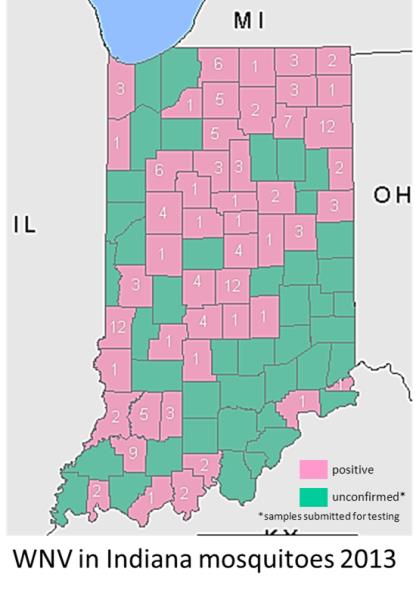
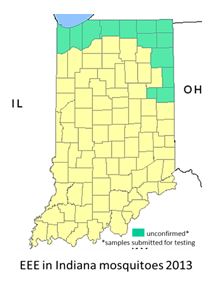
Sourced Information:
Beasley, D.W.C. et al. (2013) Resurgence of West Nile neurologic disease in the United States in 2012: What happened? What needs to be done? Antiviral Research 99:1–5.
Wendell, L.C. et al. (2013) Successful Management of Severe Neuroinvasive Eastern Equine Encephalitis. Neurocrit Care 19:111–115.
USGS Disease Maps
Van Buren County Horse Dies of Eastern Equine Encephalitis, Horse Owners Urged to Vaccinate Animals, MLIVE Media Group
Weymouth Officials Urge Caution After EEE Death, The Patriot Ledger
Resources
Mosquitoes, Purdue Extension Entomology
Shaneka Lawson, Plant Physiologist
Hardwood Tree Improvement and Regeneration Center (HTIRC)
Department of Forestry and Natural Resources, Purdue University
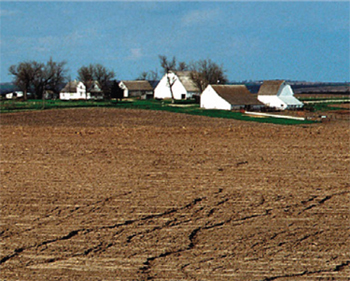 Because agriculture dominates the midwestern landscape, it has a huge impact on environmental quality. Agricultural producers are often advised to adopt practices that help to reduce the impact of agriculture on the environment. However, like all humans, they are often reluctant to change, which makes the work of conservation professionals extremely challenging. In this publication, we explore the myths and realities around what motivates farmers to adopt conservation practices. We draw on the authors’ combined research and applied practitioner experience with farmer adoption of conservation practices. Most evidence is based on studies and observations of traditional row-crop farmers in the midwestern United States.
Because agriculture dominates the midwestern landscape, it has a huge impact on environmental quality. Agricultural producers are often advised to adopt practices that help to reduce the impact of agriculture on the environment. However, like all humans, they are often reluctant to change, which makes the work of conservation professionals extremely challenging. In this publication, we explore the myths and realities around what motivates farmers to adopt conservation practices. We draw on the authors’ combined research and applied practitioner experience with farmer adoption of conservation practices. Most evidence is based on studies and observations of traditional row-crop farmers in the midwestern United States.
Adoption of Agricultural Conservation Practices
The Education Store
Purdue Extension
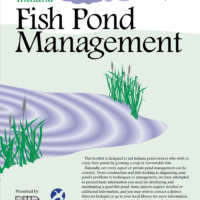 After the winter, many people’s thoughts turn to getting outside and pursuing some of our favorite hobbies. For some, that includes getting their farm pond back in order for any number of recreational activities. Depending on what you need, there are valuable resources available on the Internet that can assist you in making good management decisions to utilize your pond for maximum enjoyment. Two of the best management resources available have to do with aquatic weed management and farm pond management for recreational fishing.
After the winter, many people’s thoughts turn to getting outside and pursuing some of our favorite hobbies. For some, that includes getting their farm pond back in order for any number of recreational activities. Depending on what you need, there are valuable resources available on the Internet that can assist you in making good management decisions to utilize your pond for maximum enjoyment. Two of the best management resources available have to do with aquatic weed management and farm pond management for recreational fishing.
Aquatic weeds can deter any owner from enjoying the recreational benefits of owning a pond. Be it swimming, fishing or just aesthetics, a pond choked with weeds will benefit no one. A great resource to identify aquatic weeds and learn management techniques to control them is the Aquatic Plant Management brochure. Now is the time to use preventative measures to reduce or control aquatic weeds that can overrun your pond during the heat of the summer. There are mechanical, biological and chemical means of controlling weeds in your pond. If using aquatic herbicides, please read and follow the label direction, or if you are uncomfortable applying chemicals, there are several companies who can do the job for you. Please contact your local county extension office for contact information.
Likewise, if you have a pond that you want to manage for recreational fishing, there is a resource for you. The Indiana Department of Natural Resources has an online booklet, Indiana Fish Pond Management, for managing smaller recreational farm ponds with species and techniques applicable to Indiana. It is always best to start with a new or reclaimed pond when stocking fish and developing a management plan. If you have an existing pond with fish, the information may help you change management or realize you need to start over.
Lastly, we always get a lot of calls in the spring asking where to purchase fish. The INDNR keeps an up-to-date listing of commercial fish suppliers. This is not only for those seeking fish for recreational purposes but also for grass carp that are used for aquatic weed control. These fish need to be triploid, and only licensed suppliers are allowed to handle them in the state.
Resources:
Ask an Expert: Managing Your Property for Fish & Wildlife, Purdue Extension – Forestry and Natural Resources (FNR) YouTube Channel
Pond and Wildlife Management, Purdue Extension website
Pond Management: Stocking Fish in Indiana Ponds, The Education Store
A Pond Management Plan Template, The Education Store
The Nature of Teaching: Adaptations for Aquatic Amphibians, The Education Store
Illinois & Indiana Sea Grant, using research, outreach, and education to bring the latest science to communities and their residents.
Recent Posts
- 2024-25 Fishing Guide now available – Wild Bulletin
Posted: April 4, 2024 in Alert, Aquaculture/Fish, Aquatic/Aquaculture Resources, How To, Ponds, Wildlife - Paddlecraft Wildlife Index – MyDNR
Posted: May 8, 2023 in Aquatic/Aquaculture Resources, Great Lakes, Ponds, Safety - Natural Resources University Podcasts Earn ANREP Gold Award
Posted: April 14, 2023 in Podcasts, Ponds, Timber Marketing, Wildlife, Woodlands - A Moment in the Wild: American Toad
Posted: May 31, 2022 in Ask the Expert, Ponds - Canada Geese Begin Scouting For Nesting Areas in February
Posted: January 31, 2022 in How To, Ponds, Wildlife - Ask an Expert: Aquatic Plant Management
Posted: July 6, 2021 in Aquaculture/Fish, Aquatic/Aquaculture Resources, Ask the Expert, How To, Plants, Ponds - A Moment in the Wild: Eastern Newt
Posted: July 2, 2021 in Aquaculture/Fish, Ponds - Ask an Expert: Enjoying Indiana Herps
Posted: June 1, 2021 in Aquaculture/Fish, Aquatic/Aquaculture Resources, Ask the Expert, How To, Ponds - A Moment in the Wild: Ephemeral Wetlands
Posted: May 3, 2021 in Ponds, Wildlife - Yellow Perch Becoming Popular
Posted: March 11, 2021 in Aquaculture/Fish, Aquatic/Aquaculture Resources, How To, Ponds, Publication
Archives
Categories
- Alert
- Aquaculture/Fish
- Aquatic/Aquaculture Resources
- Ask the Expert
- Christmas Trees
- Community Development
- Disease
- Drought
- Forestry
- Forests and Street Trees
- Gardening
- Got Nature for Kids
- Great Lakes
- How To
- Invasive Animal Species
- Invasive Insects
- Invasive Plant Species
- Land Use
- Natural Resource Planning
- Nature of Teaching
- Plants
- Podcasts
- Ponds
- Publication
- Safety
- Timber Marketing
- Uncategorized
- Urban Forestry
- Webinar
- Wildlife
- Wood Products/Manufacturing
- Woodland Management Moment
- Woodlands
